PPC marketing naturally is being affected by different happenings within the ecosystem. Now that the first six months of 2020 is over, how did performance across industries change?
Every year, we see seasonality in PPC marketing, as it’s visible in many other areas. This year, due to the extraordinary conditions COVID-19 brought to our lives, we have experienced an extraordinary seasonality — and unfortunately, it’s not clear when and how the pandemic will stop completely.
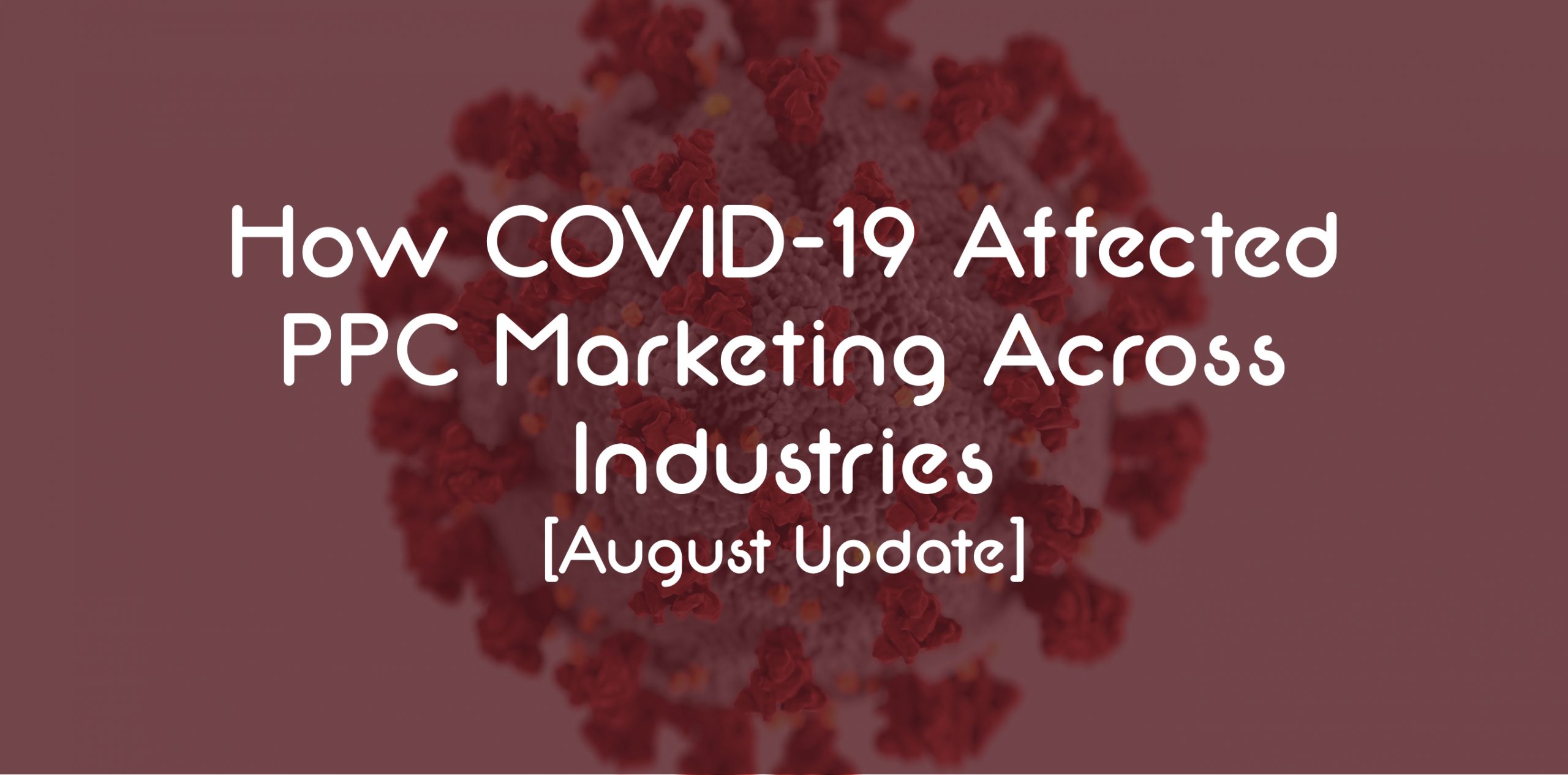
During this time, we’ve observed several changes in customer behavior;
- People started investing more in their homes. We’ve spent a lot of time in our homes, which led people to improve them.
- Food is not something we’re eating outside now — instead, we’re cooking at home and regularly making grocery shopping.
- Home entertainment is more critical than ever; leading games, consumer electronics, and overall entertainment grow.
These changes led to very chaotic changes in the market, where for our analysis in the CPC ads for the first 13 weeks, please check out our previous article in this series, “The Effect of COVID-19 on Cost-per-Click for Ads in Various Industries”.
Now that June is almost over, we at Adspert wanted to understand the changes that happened after the initial shock in the market and which industries performed well, and which ones badly. We’ve analyzed the digital search, display, and shopping ad data on our platform and came up with a map that shows how the market reacted to the changes and what kind of a future we should expect.
Overview — How did the market change?
We’ve mentioned the spike in the markets in our previous article on April 17th. Within that time, we’ve seen a spike in several industries in the 12th week of 2020. It looks like that spike was just the beginning.
Looking from a revenue standpoint, we see that Homewares, Consumer Electronics, Entertainment, and Food and Beverages showed unusual revenue growth. Even though we had seen growth in these industries before the 13th week of 2020, they had other jumps in the following weeks.
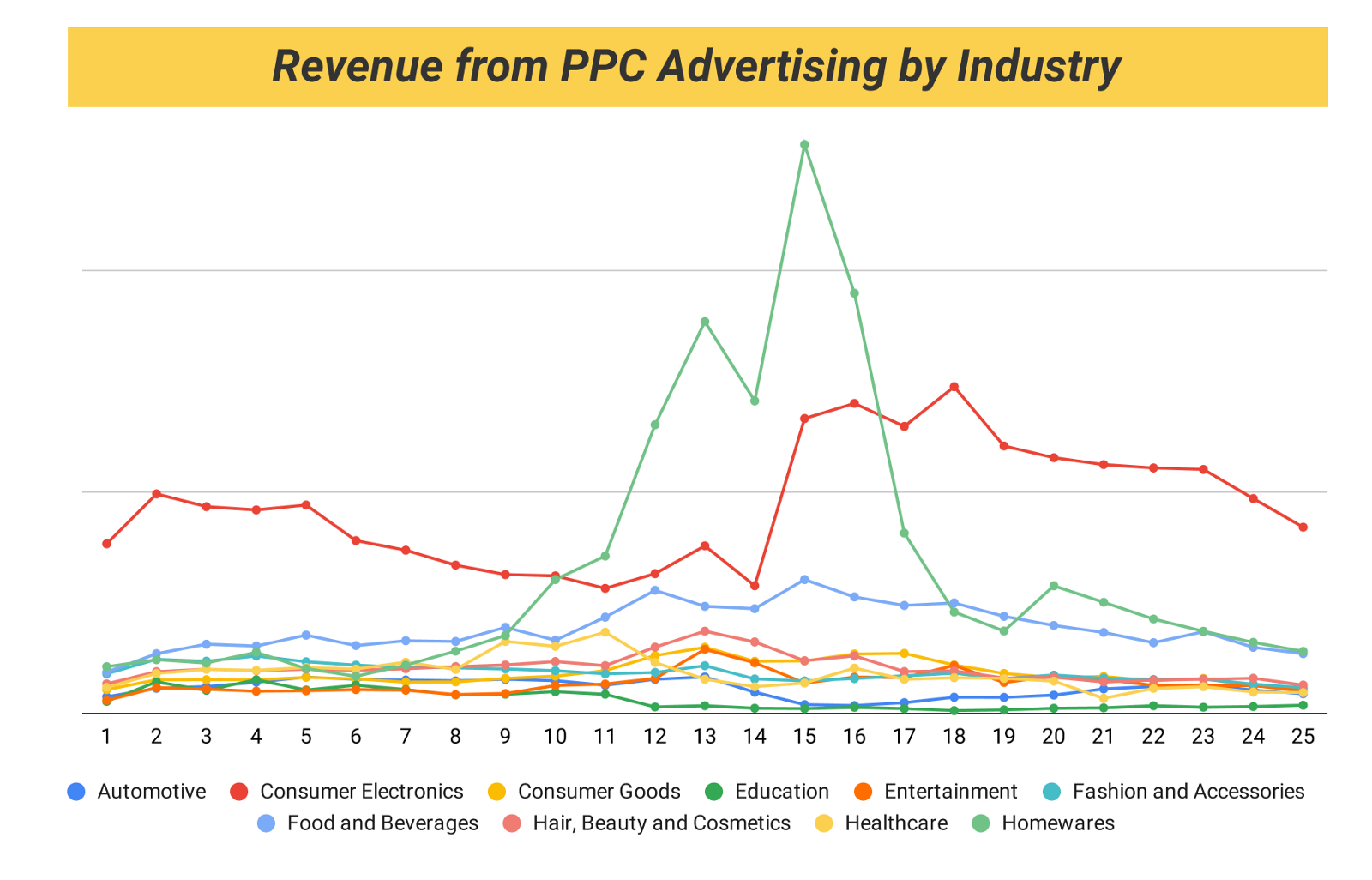
Looking at how the revenue changed week over week after the EU closed its borders in the 12th week of 2020, industries either showed a drop or arise due to consumer demand change. As we can see from the table;
- Entertainment, Homewares, Food and Beverages, Consumer Goods, and Hair, Beauty, and Cosmetics industries have been positively affected for the following weeks.
- Automotive, Education, Fashion and Industries, and Healthcare are affected negatively in the initial shock.
After the initial shock, as we have mentioned, consumer behavior shifted to invest more in their homes, which led to growth in Consumer Electronics after the 15th week and an increase in Homewares. Even though the Consumer Electronics industry revenue got into a decreasing trend, it’s still way higher than the season normals. We can say the same thing for Homewares as well.
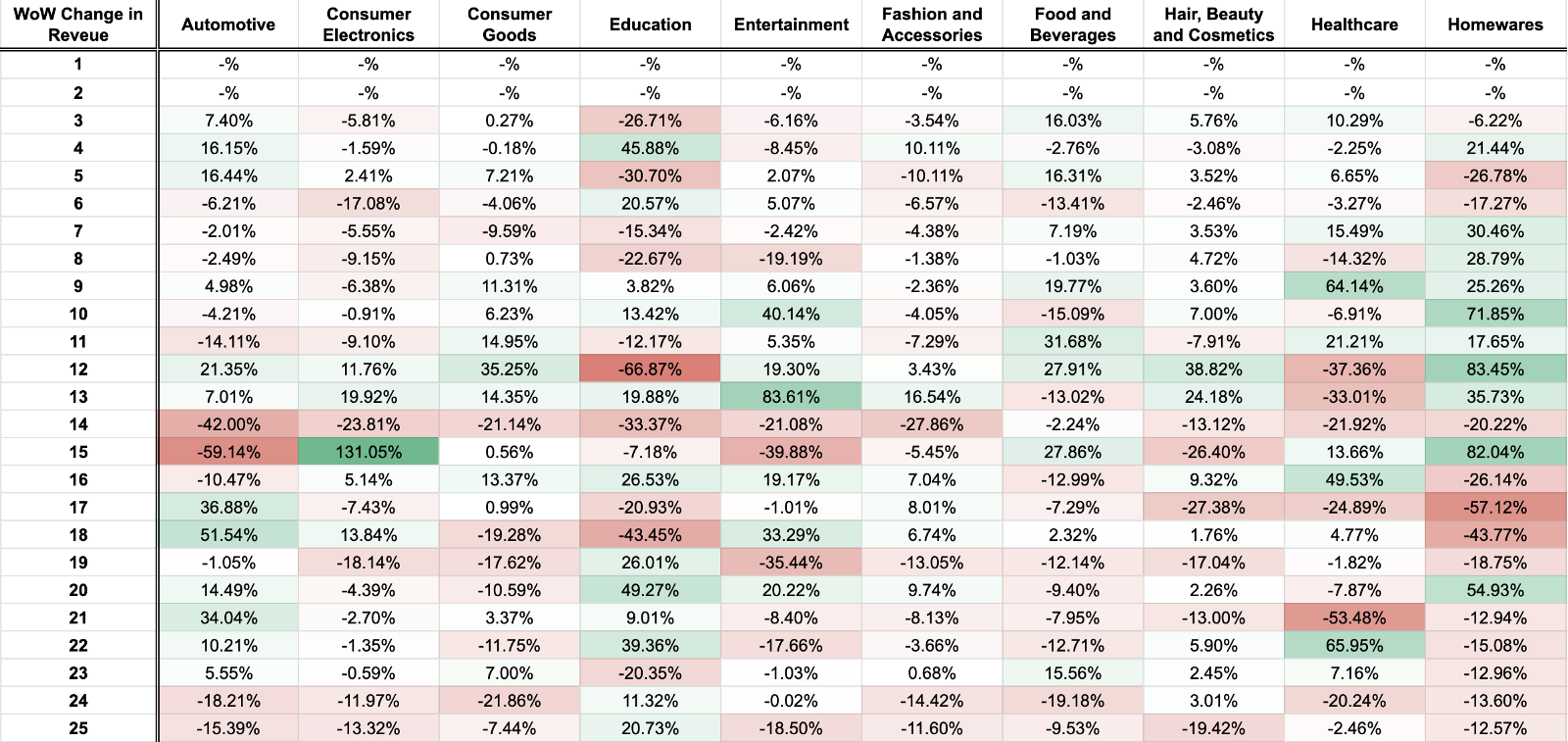
The week over week change shows the dramatic results of the fluctuation. As seen, the revenue fluctuation rates across different industries are very high. Although it’s like that, Consumer Goods, Fashion and Accessories, Food and Beverages and Hair, Beauty, and Cosmetics industries have experienced a slightly less fluctuation.
As can be seen, Homewares and Consumer Electronics are in a continuous decrease due to the peaks they’ve experienced during the initial weeks of the COVID-19 craze.

The fluctuation also affected the CPC levels across the industries. Almost all industries showed a drop in their CPC levels, either due to the increase in the demand of the market or the companies’ bidding strategies. In this example specifically, the more agile companies have become more successful in managing this situation, whereas slower organizations might have been affected negatively.
The Winner Industries
As we’ve mentioned at the beginning of the article, Entertainment, Homewares, Food and Beverages, Consumer Goods, and Hair, Beauty, and Cosmetics industries have been affected very positively from the changes.
Overall, their revenue has grown, and mostly the advertising performance improved simultaneously due to the increasing demand.
Homewares
One of the biggest winners is the Homewares industry. When we check the industry advertising performance data, some points look very clear.
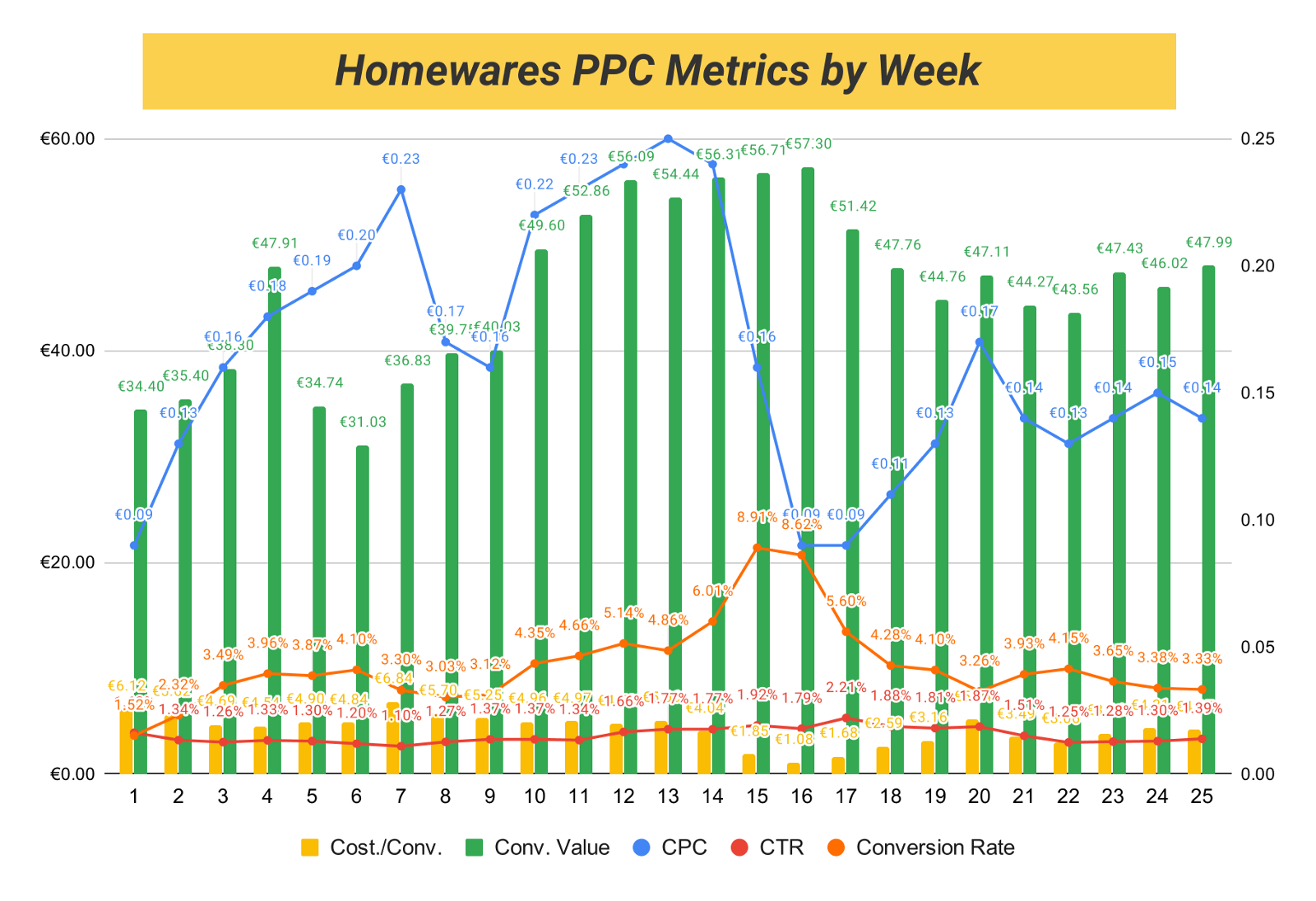
- The conversion value of the industry has increased very significantly.
- The conversion rate of the advertisements has risen to 8.91% at the highest level — which is a very high conversion rate.
- Cost per conversion has seen its lowest level in the 16th week of 2020, with €1.08.
- Like cost per conversion, CPC has seen its lowest level at the 16th week of 2020 with €0.09.
Food and Beverages
This is the most straightforward industry that showed growth among other industries. As predicted, the Food and Beverages industry’s CTR, conversion rate, and conversion value have increased.
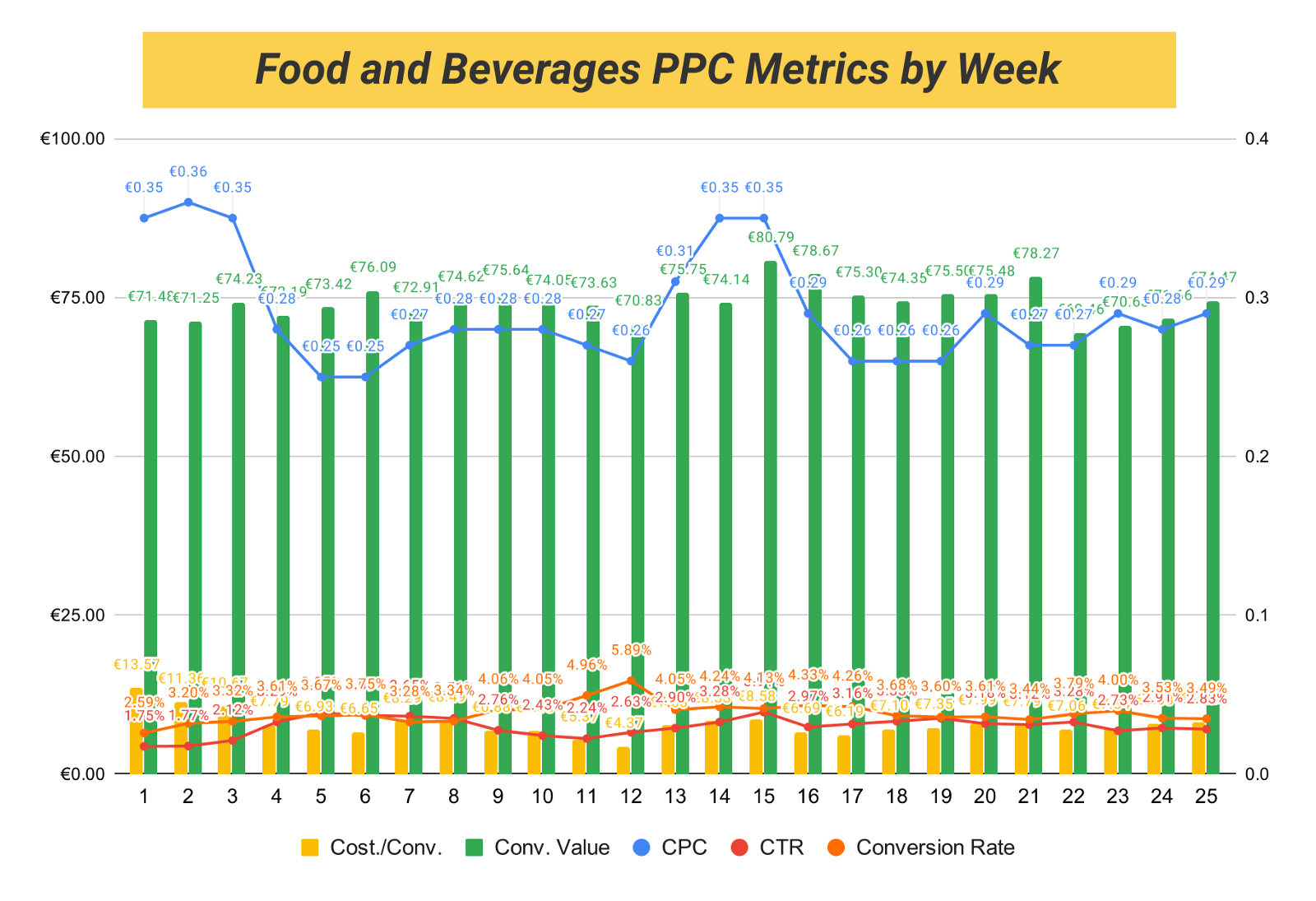
- CPC has dropped to €0.26 in the 12th week, where the panic buying occurred. After that, CPC started increasing; considering the increasing ad spending, we assume this happened due to the competition.
- Conversion rate has seen its highest level at 11th and 12th weeks, with 4.96% and 5.89% consecutively.
- Cost per conversion value also fluctuated a lot — hence it’s not very easy to say something meaningful on that data.
Consumer Goods
Another industry that’s expected to grow is Consumer Goods. As we observe, we see that CPC has decreased, and CTR has increased significantly.
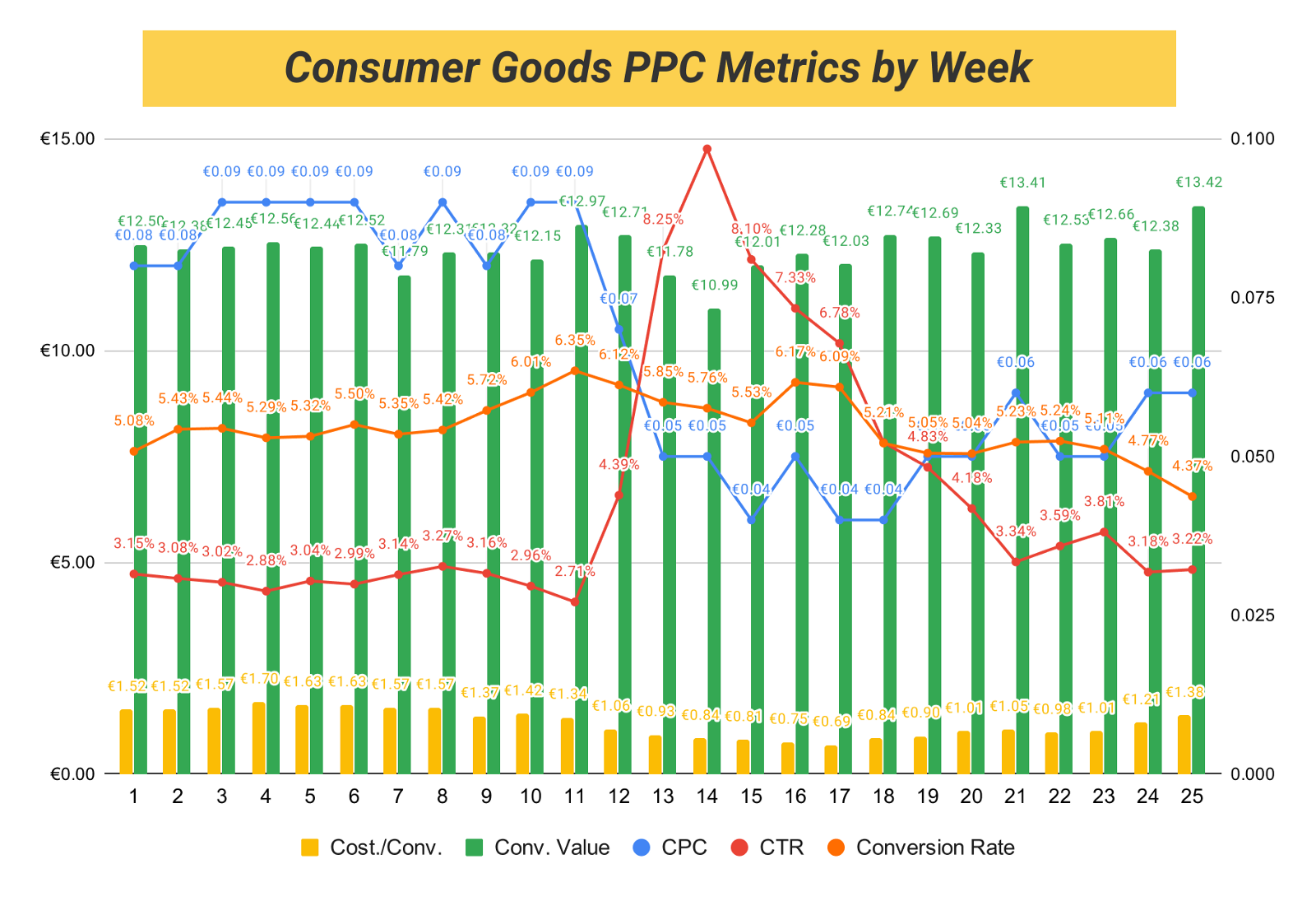
- The CTR has its peak in the 14th week, with 9.84%.
- CPC has lowered to €0.04 at its lowest levels.
- We see that the conversion value has dropped slightly in the 13th and 14th weeks.
- The cost per conversion also dropped to €0.69.
Consumer Electronics
Consumer Electronics is already an industry with a large basket size. Hence, when talked about it, numbers tend to be more significant. Even though digital advertising revenue has increased, it doesn’t have as significant changes as the Homewares category.
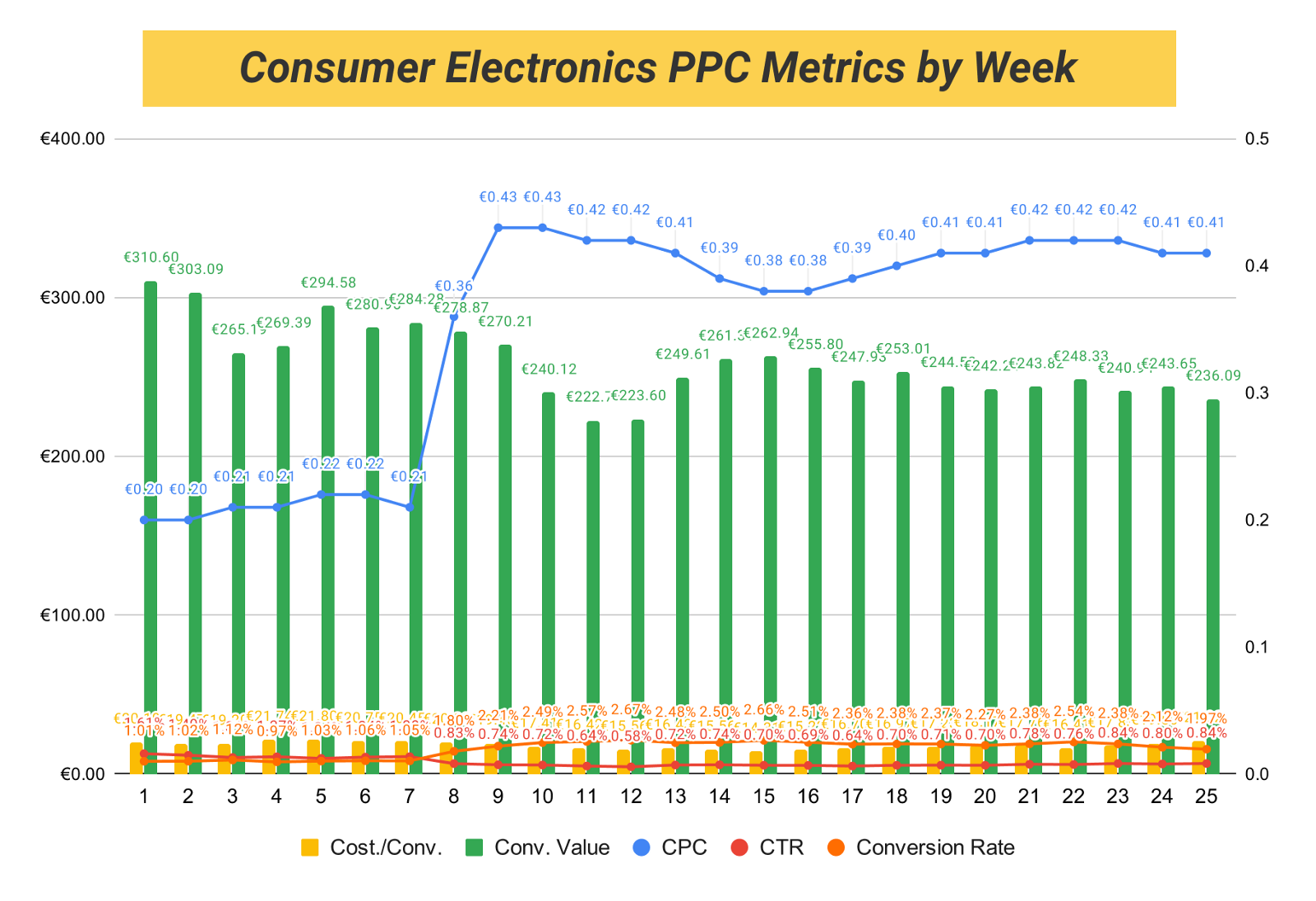
- CPC levels decreased by around 20% at its lowest level, with €0.38.
- Cost per conversion has seen its lowers value with €14.31 in the 15th week.
- CTR has decreased, and the conversion rate has increased. Considering the small change in the CPC, we can say that consumers shopping in this category are more cautious about the price due to the high prices of the products.
Entertainment
Entertainment is also very relevant to Consumer Electronics due to their similar behavior. Considering people spending more time in their houses, it was also expected to see growth in this category.

- We see that the conversion value has seen €86.27 at its highest.
- Along with conversion value, CPC also increased, where the increasing cost per account also indicates the competition.o
Hair, Beauty, and Cosmetics
Not very expectedly, the Hair, Beauty, and Cosmetics industry almost doubled in volume and revenue in the last three months. We are assuming that this growth occurred due to the budgets shifting to e-commerce rather than traditional retail.

- The conversion value has decreased continuously.
- CPC value has seen its lowest in the 23rd week with €0.23.
- The Conversion Rate has seen its peak in the 12th week with 7.86%.
Industries That Performed Poorly
Not all industries are affected in the same way from COVID-19. As observed, Automotive, Education, and Healthcare have been affected negatively.
The term negative here doesn’t indicate the digital advertising performance, where we’ve seen improvements in the performance of digital advertising at some of these industries. Instead, it shows that these industries lost volume and revenue due to COVID-19.
Automotive
Automotive is one of the industries that hit very hard. Impressions and clicks almost went half of what they were in the past, and revenue dropped to even lower levels.
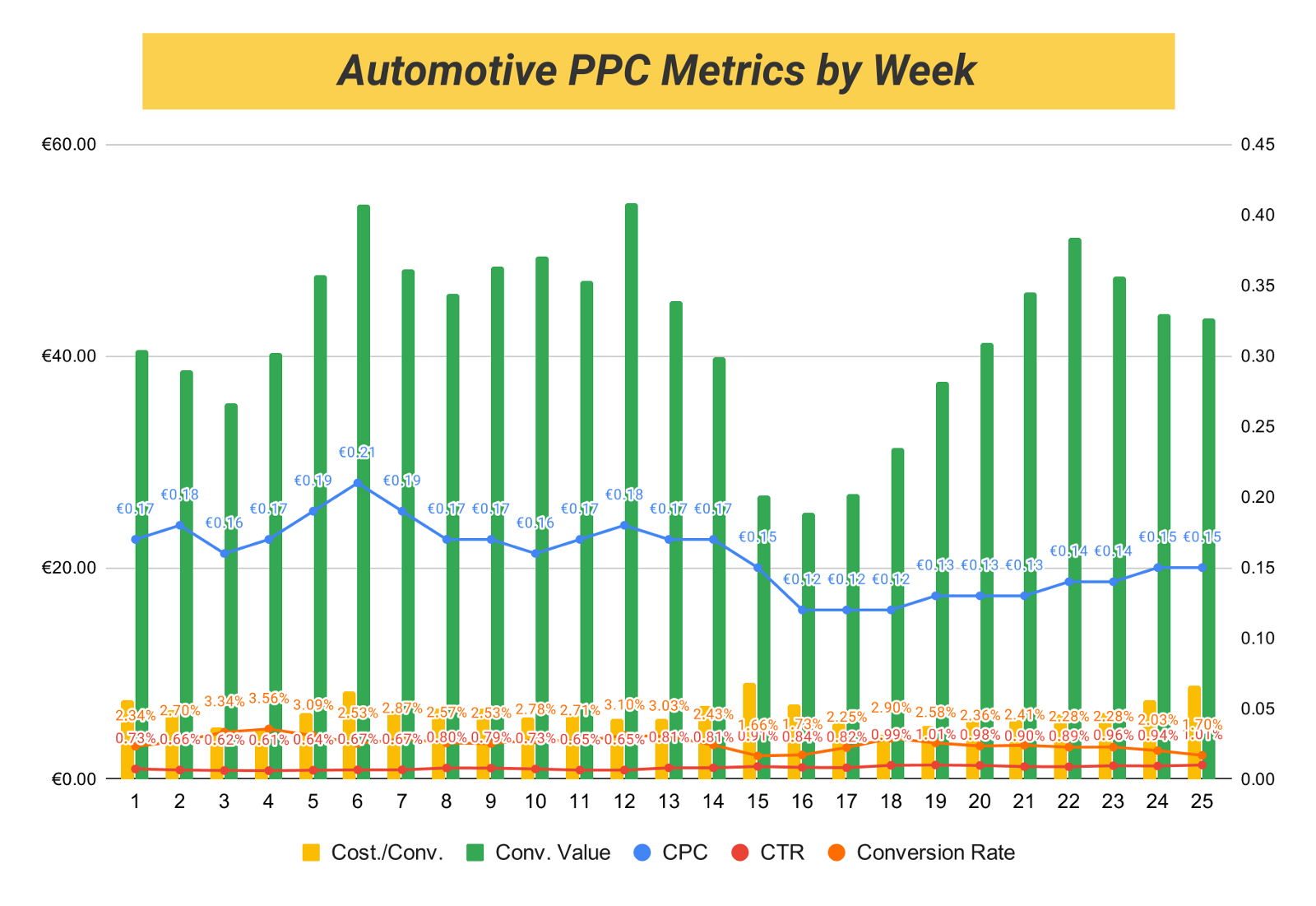
- We see a significant drop on the CPC, where the demand is deficient, so this metric doesn’t indicate a lot of meaning.
- Most of the metrics changed due to the lowering volume, so it’s not very meaningful.
Healthcare
Healthcare products have lost half of its volume and revenue. Although the high-level performance went bad, some of the advertising metrics improved.

Education
Education is one of the most affected industries because of the COVID-19 situation. The revenue, overall traffic, and the advertising performance metrics all went badly. The recent data shows promising results in the industry, and things are getting back to normal.
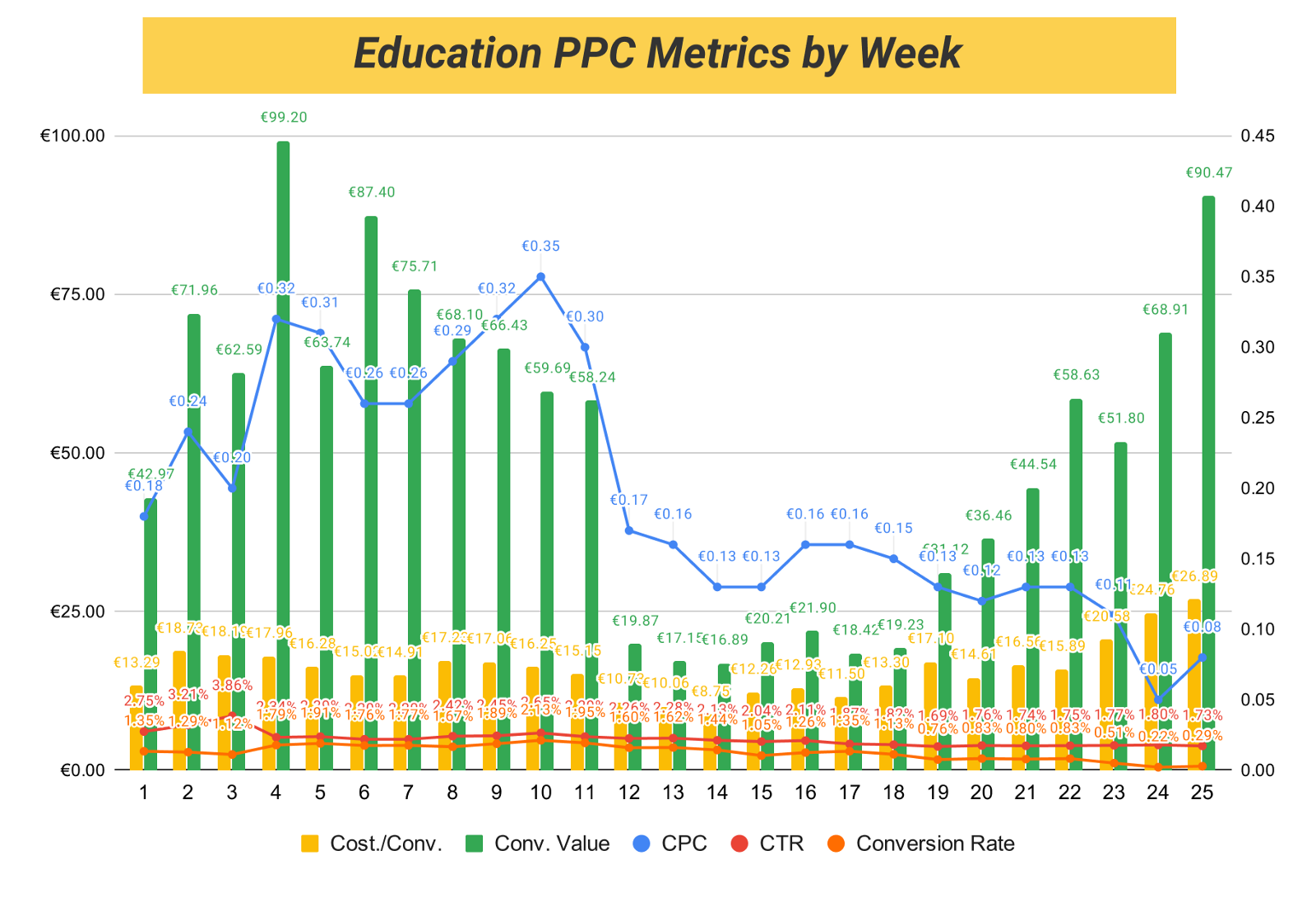
- The conversion value metrics went almost one-fifth of how it was in the past. Hence, there is a massive drop.
- The CPC also lowered, but it didn’t drop as much as the conversion value has fallen.
- In recent weeks, there was a growth, so it’s going back to normals.
Takeaways and Suggestions
The market is evolving, but it was always like that. Amazon wasn’t here 30 years ago; e-commerce wasn’t that big until 15 years ago, Google Ads launched 16 years ago. So, COVID-19 didn’t trigger something far beyond what has been expected; instead, it accelerated the shift and brought new consumer behavior to the place. Hence, along with the instant actions we can take, we should consider this part of the growth of digital marketing and change our overall mindset.
Below, you can find our takeaways from the current situations of the market and our suggestions for you to be ready for the next big market shift.
The New Normal is here, and fluctuations are mostly over.
Even though there have been fluctuations, we’re not expecting any new volatility in most industries other than the seasonal effects. The New Normal has arrived, and we have new behaviors.
The expected shrinkage in the hospitality industry will shapeshift.
Due to the people’s hesitation because of COVID-19 and legal transportation limitations, the hospitality industry is expected to shrink. The potential spending in this will either shift to the local tourism and automotive or home entertainment investment.
Try to be more flexible.
Many industry experts suggest, but to be more agile in the changes in the market, try to be more flexible in your planning. Rather than doing annual or half-yearly plans, try to do quarterly or monthly budgeting/planning in fluctuating product categories.
New e-commerce growth opportunities are there.
COVID-19’s impact on retail-led people to spend more on e-commerce. To increase your share within this situation, try to expand your reach via expanding to new marketplaces and new advertising platforms, or perhaps to new geographies. Don’t forget that if you win a category in a country, it might be a good idea to expand to new markets.
There are new shoppers in different categories.
The shopper profile has changed — so update your persona or customer segment reports. You can, of course, at some point, go back to your existing segments, but for now, updating it would improve the effectiveness of your advertising campaigns.
Reflect faster by leveraging AI in digital marketing.
Reflecting on the market changes is not easy — and we know it. Using Artificial Intelligence that updates your digital advertising campaigns reflecting on the changes in the market is very important.
The Data
The data included in this article is based on anonymized data on the Adspert platform. We have analyzed data we had processed between 01/01/2020 and 25/06/2020, and aggregated by weeks and months to reflect the trends. To show the representative results, we didn’t dive into all industries, instead focused on the categories with a market representative volume.
All industries are considered to generate general and industry-free analysis. For the detailed analysis, 15 industries are considered; Food and Beverages, Automotive, Consumer Electronics, Consumer Goods, Education, Entertainment, Fashion and Accessories, Hair, Beauty and Cosmetics, Healthcare, Homewares.
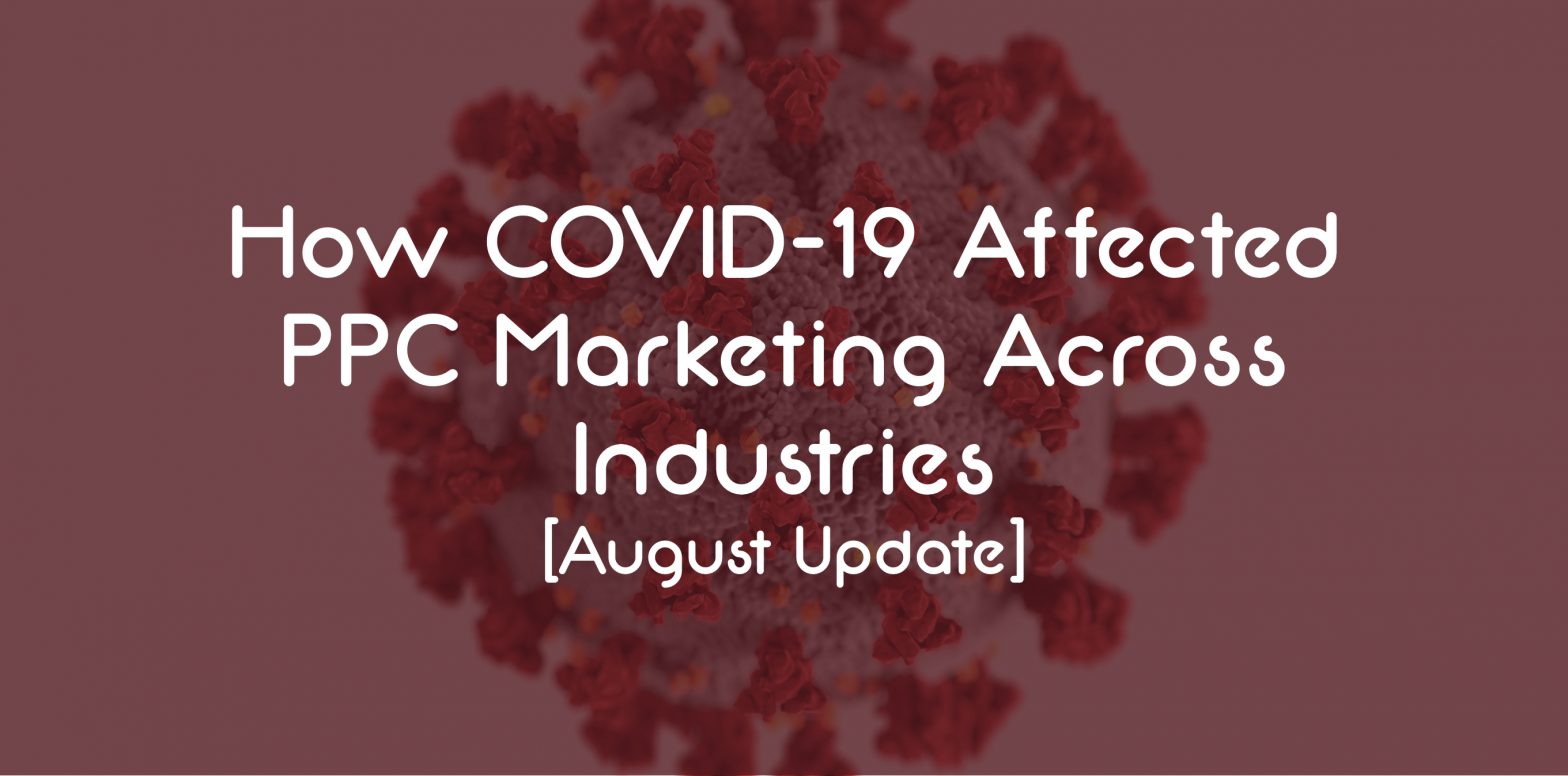
Leave a Reply